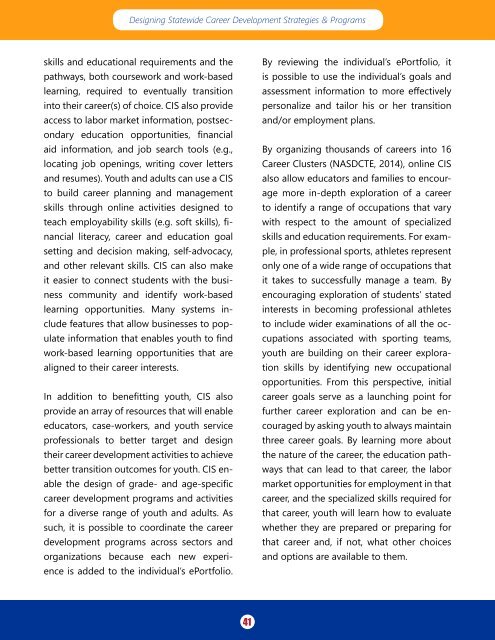Designing Statewide Strategies & Programs
DesigningStatewideCareerDevelopmentStrategiesProgramsPub_0
DesigningStatewideCareerDevelopmentStrategiesProgramsPub_0
Create successful ePaper yourself
Turn your PDF publications into a flip-book with our unique Google optimized e-Paper software.
<strong>Designing</strong> <strong>Statewide</strong> Career Development <strong>Strategies</strong> & <strong>Programs</strong><br />
skills and educational requirements and the<br />
pathways, both coursework and work-based<br />
learning, required to eventually transition<br />
into their career(s) of choice. CIS also provide<br />
access to labor market information, postsecondary<br />
education opportunities, financial<br />
aid information, and job search tools (e.g.,<br />
locating job openings, writing cover letters<br />
and resumes). Youth and adults can use a CIS<br />
to build career planning and management<br />
skills through online activities designed to<br />
teach employability skills (e.g. soft skills), financial<br />
literacy, career and education goal<br />
setting and decision making, self-advocacy,<br />
and other relevant skills. CIS can also make<br />
it easier to connect students with the business<br />
community and identify work-based<br />
learning opportunities. Many systems include<br />
features that allow businesses to populate<br />
information that enables youth to find<br />
work-based learning opportunities that are<br />
aligned to their career interests.<br />
In addition to benefitting youth, CIS also<br />
provide an array of resources that will enable<br />
educators, case-workers, and youth service<br />
professionals to better target and design<br />
their career development activities to achieve<br />
better transition outcomes for youth. CIS enable<br />
the design of grade- and age-specific<br />
career development programs and activities<br />
for a diverse range of youth and adults. As<br />
such, it is possible to coordinate the career<br />
development programs across sectors and<br />
organizations because each new experience<br />
is added to the individual’s ePortfolio.<br />
By reviewing the individual’s ePortfolio, it<br />
is possible to use the individual’s goals and<br />
assessment information to more effectively<br />
personalize and tailor his or her transition<br />
and/or employment plans.<br />
By organizing thousands of careers into 16<br />
Career Clusters (NASDCTE, 2014), online CIS<br />
also allow educators and families to encourage<br />
more in-depth exploration of a career<br />
to identify a range of occupations that vary<br />
with respect to the amount of specialized<br />
skills and education requirements. For example,<br />
in professional sports, athletes represent<br />
only one of a wide range of occupations that<br />
it takes to successfully manage a team. By<br />
encouraging exploration of students’ stated<br />
interests in becoming professional athletes<br />
to include wider examinations of all the occupations<br />
associated with sporting teams,<br />
youth are building on their career exploration<br />
skills by identifying new occupational<br />
opportunities. From this perspective, initial<br />
career goals serve as a launching point for<br />
further career exploration and can be encouraged<br />
by asking youth to always maintain<br />
three career goals. By learning more about<br />
the nature of the career, the education pathways<br />
that can lead to that career, the labor<br />
market opportunities for employment in that<br />
career, and the specialized skills required for<br />
that career, youth will learn how to evaluate<br />
whether they are prepared or preparing for<br />
that career and, if not, what other choices<br />
and options are available to them.<br />
41


